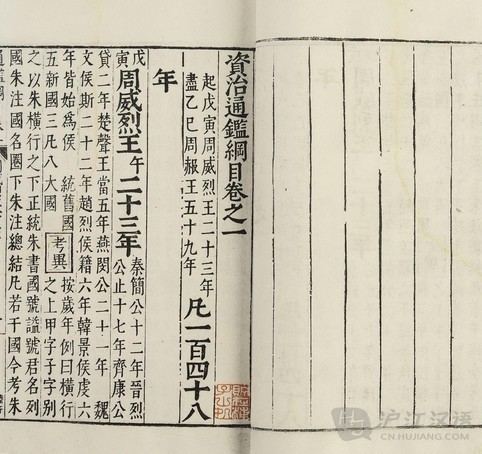Country China Publication date 1084 Originally published 1084 | Media type Scrolls | |
 | ||
Ancient history books Book of Han, Book of the Later Han, Records of the Three Kingdoms, Stories about Ming Dynasty, 1587 - a Year of No Significance | ||
The Zizhi Tongjian (Chinese: 資治通鑑; literally: "Comprehensive Mirror in Aid of Governance") is a pioneering reference work in Chinese historiography, published in 1084 , in the form of a chronicle. In 1065 AD, Emperor Yingzong of Song ordered the great historian Sima Guang (1019–1086 AD) to lead with other scholars such as his chief assistants Liu Shu, Liu Ban and Fan Zuyu, the compilation of a universal history of China. The task took 19 years to be completed, and, in 1084 AD, it was presented to his successor Emperor Shenzong of Song. The Zizhi Tongjian records Chinese history from 403 BC to 959 AD, covering 16 dynasties and spanning across almost 1,400 years, and contains 294 volumes (巻) and about 3 million Chinese characters.
Contents
The text
The principal text of the Zizhi Tongjian was recorded on 294 juan (Chinese: 卷), which are scrolls corresponding to a volume, chapter, or section of the work. The text is a chronological narrative of the history of China from the Warring States to the Five Dynasties. The major contributor, Sima Guang, was active in each step from collecting events and dates from various previous works to drafting and publication.
Sima Guang left the traditional usage in Chinese historiography. For almost 1,000 years since the Shiji was written, standard Chinese dynastic histories had primarily divided chapters between annals (紀) of rulers, and biographies (傳) of officials. In Chinese terms, the book changed the format of histories from biographical style (Chinese: 紀傳體) to chronological style (Chinese: 編年體), which is better suited for analysis, activism and criticism. According to Wilkinson: "It had an enormous influence on later Chinese historical writing, either directly or through its many abbreviations, continuations, and adaptations. It remains an extraordinarily useful first reference for a quick and reliable coverage of events at a particular time."
The 294 juan sweep through 11 Chinese historical periods (Warring States, Qin, Western Han, Eastern Han, Three Kingdoms, Jin and the Sixteen Kingdoms, Southern and Northern Dynasties, Sui, Tang, and Five Dynasties). It was one of the largest historical magna opera in history.
Derivative and commented works
In the 12th century, Zhu Xi produced a reworked, condensed version of Zizhi Tongjian, known as Tongjian Gangmu, or Zizhi Tongjian Gangmu (通鑒綱目). This condensed version was itself later translated into Manchu as ᡨᡠᠩ
ᡤᡳᠶᠠᠨ
ᡬᠠᠩ
ᠮᡠ Wylie: Tung giyan g'ang mu, Möllendorff: Tung giyan g'ang mu, upon the request of Qing Dynasty Kangxi Emperor. This Manchu version was itself translated into French by French Jesuit missionary Joseph-Anna-Marie de Moyriac de Mailla. His twelve-volume translation, "Histoire générale de la Chine, ou Annales de cet Empire; traduit du Tong-kien-kang-mou par de Mailla" was published posthumously in Paris in 1777-1783.
The Zhonghua Shuju edition contains textual criticism made by Yuan Dynasty historian Hu Sanxing.
The whole of Zizhi tongjian Volumes 1-8, covering the years 403-207 BCE, have been translated into English with copious notes and annotations. Some additional sections of Zizhi tongjian pertaining to China's relations with the Xiongnu have been translated into English.
Contents
The book consisted of 294 volumes, of which the following number describe each respective dynastic era:
- 5 volumes - Zhou (1046-256 BC)
- 3 volumes - Qin (221-207 BC)
- 60 volumes - Han (206 BC-220 AD)
- 10 volumes - Wei (220-265)
- 40 volumes - Jin (265-420)
- 16 volumes - Liu Song (420-479)
- 10 volumes - Qi (479-502)
- 22 volumes - Liang (502-557)
- 10 volumes - Chen (557-589)
- 8 volumes - Sui (589-618 AD)
- 81 volumes - Tang (618-907)
- 6 volumes - Later Liang (907-923)
- 8 volumes - Later Tang (923-936)
- 6 volumes - Later Jin (936-947)
- 4 volumes - Later Han (947-951)
- 5 volumes - Later Zhou (951-960)
